- [email protected]
- +254 723 065019
- Mon - Sat 9:00 AM - 5:00 PM
- Login or Register
- Favorites
9.2 Case Study Review: Waste Management Success Stories
Lesson 9.2: Case Study Review: Waste Management Success Stories
Welcome to Lesson 9.2: Case Study Review: Waste Management Success Stories. In this lesson, we will turn our attention to one of the most pressing environmental challenges of our time: waste management. As we continue to strive for a more sustainable future, effective waste management becomes crucial in reducing environmental impact, conserving resources, and fostering a circular economy.
Waste management encompasses a broad range of practices and strategies aimed at minimizing waste production, maximizing recycling, and managing waste disposal responsibly. Successful waste management not only helps protect the environment but also contributes to economic efficiency and public health.
In this lesson, we will explore several case studies that showcase innovative and effective waste management strategies from around the globe. These success stories will highlight how different communities, businesses, and organizations have tackled waste management challenges and achieved impressive results. By examining these examples, you’ll gain valuable insights into practical solutions and best practices that can be adapted to various contexts.
As we review these success stories, we’ll focus on:
- Innovative Techniques: How novel approaches and technologies have transformed waste management practices.
- Community and Business Involvement: The role of stakeholders in achieving successful waste management outcomes.
- Environmental and Economic Impact: The tangible benefits realized from effective waste management strategies.
Prepare to dive into inspiring case studies that demonstrate how thoughtful waste management practices can lead to significant environmental and societal benefits.
Objective:
By the end of Lesson 9.2, learners will:
- Review and Analyze Case Studies: Examine a range of successful waste management initiatives within the construction industry, gaining insights into effective waste management practices.
- Evaluate Strategies: Assess the various strategies and techniques employed in these case studies to understand their impact and effectiveness.
- Assess Outcomes: Determine the results and benefits achieved from implementing these waste management strategies, including environmental, economic, and operational impacts.
- Identify Best Practices and Challenges: Recognize the best practices that contributed to successful waste management and understand the challenges encountered. Learn how these lessons can be applied to future construction projects to improve waste management practices.
This lesson aims to provide a comprehensive understanding of how effective waste management can be achieved in construction, using real-world examples to illustrate successful approaches and inform future initiatives.
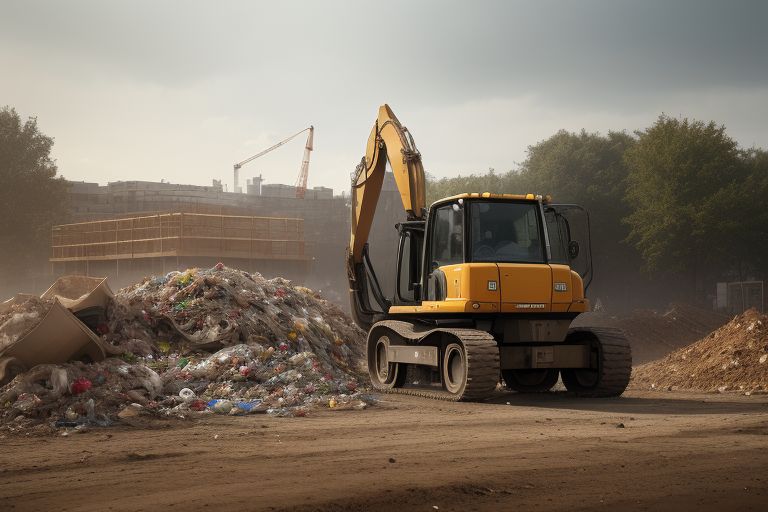
1. Introduction to Waste Management Success Stories
In the construction industry, effective waste management is crucial for minimizing environmental impact, reducing costs, and promoting sustainability. This section introduces you to various case studies that showcase successful waste management initiatives in construction projects. By exploring these success stories, you will gain valuable insights into how different strategies and technologies have been employed to handle construction waste efficiently.
We will delve into projects that have excelled in managing waste through innovative approaches, rigorous planning, and strategic implementation. These case studies will highlight the challenges faced, solutions developed, and the outcomes achieved, providing a comprehensive understanding of best practices in waste management.
As you review these success stories, consider how the lessons learned can be applied to future projects. Reflect on the strategies that contributed to their success and think about how similar approaches might be adapted to address waste management challenges in your own construction projects. This introduction will set the stage for an in-depth exploration of real-world examples that exemplify excellence in managing construction waste.
Key Points:
a. Purpose of Case Studies
Case studies are instrumental in understanding and implementing successful waste management practices in the construction industry. They offer detailed, real-world examples of how various strategies and technologies have been employed to effectively manage and reduce construction waste. By analyzing these case studies, learners gain insights into practical applications of waste management techniques, seeing how they work in actual projects.
Key Aspects:
- Real-World Application: Case studies provide concrete examples of how waste management strategies are applied in different construction scenarios, illustrating the practical challenges and solutions encountered.
- Effectiveness of Strategies: They demonstrate the impact of specific waste management practices, such as waste reduction methods, recycling initiatives, and innovative disposal techniques, showing how these practices can lead to significant reductions in waste generation and lower operational costs.
- Enhanced Sustainability: By examining successful waste management cases, learners can understand how these practices contribute to greater sustainability in construction. This includes reducing the environmental footprint of projects and supporting broader sustainability goals.
- Inspiration for Future Projects: Success stories from case studies offer valuable insights and inspiration for developing and refining waste management approaches in future projects. They highlight best practices, innovative solutions, and lessons learned, providing a foundation for implementing effective waste management strategies in various contexts.
Overall, case studies are a crucial tool for exploring effective waste management practices, enabling learners to apply these lessons to their own projects and drive improvements in sustainability and efficiency.
b. Structure of Analysis
To effectively analyze each case study, a structured framework will be used to uncover the key elements of successful waste management. The analysis will include the following components:
1. Project Overview:
A comprehensive summary of the project, including its scope, objectives, and context. This section sets the stage for understanding the project’s environment and the specific waste management challenges it faced.
2. Waste Management Strategies:
A detailed examination of the strategies and techniques employed to manage waste effectively. This includes:
-
- Waste Reduction Methods: Techniques used to minimize waste generation at the source.
- Recycling Practices: Approaches for recycling materials and repurposing waste.
- Disposal Techniques: Methods employed for the safe and efficient disposal of any remaining waste.
3. Outcomes:
An evaluation of the results achieved through the waste management strategies. This includes:
-
- Reductions in Waste Generation: Measurement of the success in lowering the amount of waste produced.
- Cost Savings: Analysis of any financial benefits resulting from effective waste management.
- Environmental Impact: Assessment of the environmental benefits, such as reduced landfill use and lower carbon emissions.
4. Challenges:
An exploration of the obstacles encountered during the implementation of waste management strategies and the solutions devised to address these challenges. This section will highlight difficulties such as logistical issues, cost constraints, or technical problems, and the innovative solutions that were implemented to overcome them.
By systematically analyzing these components, learners will gain a comprehensive understanding of the factors contributing to the success of waste management initiatives. This approach will help in identifying best practices and opportunities for applying similar strategies to their own projects, thereby enhancing their ability to manage waste effectively in the construction industry.
Reflection Element:
Reflect on how successful waste management practices from different projects can be applied to improve waste management in your own projects.
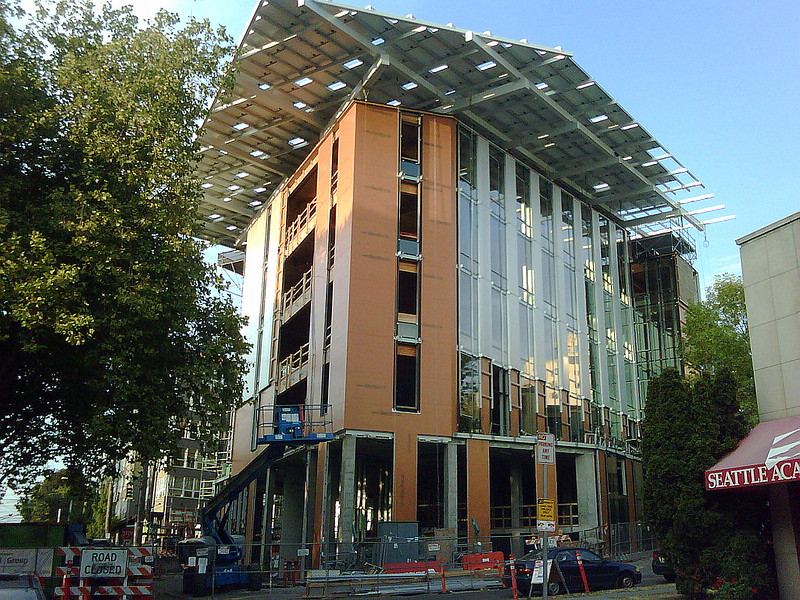
© Copyright Joe Wolf and licensed for Attribution-NoDerivs 2.0 Generic under this Creative Commons Licence.
2. Case Study 1: The Bullitt Center, Seattle
In this section, we will explore the Bullitt Center in Seattle, often hailed as one of the greenest commercial buildings in the world. This case study offers a compelling look into how a leading-edge approach to waste management can contribute to overall building sustainability.
The Bullitt Center is renowned not only for its innovative design and energy efficiency but also for its rigorous waste management practices. By examining this project, learners will gain insights into how integrating waste reduction strategies from the outset can achieve significant environmental and operational benefits.
We will delve into the specifics of the Bullitt Center’s waste management practices, assess their effectiveness, and understand the challenges encountered. Through this case study, you will uncover valuable lessons on applying waste management principles to enhance sustainability in construction projects.
Project Overview:
a. Description:
-
- Location: Seattle, USA
- Type: Office Building
Key Features:
-
- Greenest Commercial Building: The Bullitt Center is recognized as the “greenest commercial building in the world,” embodying the highest standards of sustainability and environmental stewardship.
- Advanced Waste Management: The building integrates cutting-edge waste management practices to support its ambitious environmental goals, showcasing leadership in minimizing waste and maximizing resource efficiency.
- High Waste Diversion Rate: Achieved an impressive 98% diversion rate from landfills during construction, through extensive recycling and material reuse efforts.
- Material Selection: Utilized materials with high recycled content and sourced them locally to reduce transportation-related waste and support local economies.
- Waste Reduction Policies: Implemented stringent waste reduction measures, including source separation and comprehensive composting programs, to minimize overall waste generation and enhance recycling efforts.
b. Waste Management Strategies:
1. Construction Waste Diversion:
The Bullitt Center achieved an impressive 98% diversion rate from landfills during construction. This exceptional performance was realized through a dedicated effort to recycle and reuse materials, significantly reducing the volume of waste sent to landfills. The project’s focus on a circular economy approach exemplifies best practices in sustainable construction waste management.
2. Material Selection:
In its commitment to sustainability, the Bullitt Center emphasized the use of materials with high recycled content and sourced them locally. This strategy not only minimized the environmental impact associated with the transportation of materials but also supported local economies. By choosing materials with lower environmental footprints, the project reduced waste and reinforced its sustainability goals.
3. Waste Reduction Policies:
The Bullitt Center established comprehensive waste reduction policies, including the meticulous source separation of different waste streams and the implementation of extensive composting programs. These policies facilitated efficient waste management throughout the building’s lifecycle, ensuring that waste was processed in a manner that maximized recycling and minimized landfill use.
c. Outcomes:
1. Performance:
The Bullitt Center’s waste management strategies led to a remarkable achievement of minimal construction waste being sent to landfills. By maintaining a 98% diversion rate, the project not only realized significant cost savings but also demonstrated its commitment to high environmental standards. This efficient waste management contributed to the building’s overall sustainability, aligning with its goal to be a leading example of green construction.
2. Recognition:
The Bullitt Center has received widespread acclaim for its exceptional waste management practices and its comprehensive approach to sustainability. It has been lauded as a benchmark for integrating effective waste reduction principles into large-scale construction projects. The building’s success in managing waste efficiently underscores its role as a model for future developments aiming to achieve similar environmental and operational goals.
d. Challenges:
1. Coordination:
A major challenge faced during the Bullitt Center project was ensuring that all contractors and suppliers complied with the stringent waste reduction and recycling practices established for the construction phase. Effective coordination and clear communication were crucial to align all parties with the project’s high sustainability standards. Maintaining these standards required ongoing oversight and engagement to ensure that waste management goals were consistently met across all stages of the construction process.
2. Initial Costs:
The project encountered higher upfront costs due to investments in sustainable materials and advanced waste management systems. While these initial expenses were substantial, they were mitigated by the long-term benefits realized, including operational cost savings and improved environmental performance. The investment in these systems not only supported the project’s sustainability objectives but also demonstrated that the long-term advantages of waste management can outweigh the initial financial outlay.
Reflection Element:
Reflect on the effectiveness of the waste management strategies used in the Bullitt Center and think about how these strategies contributed to the building’s overall sustainability.
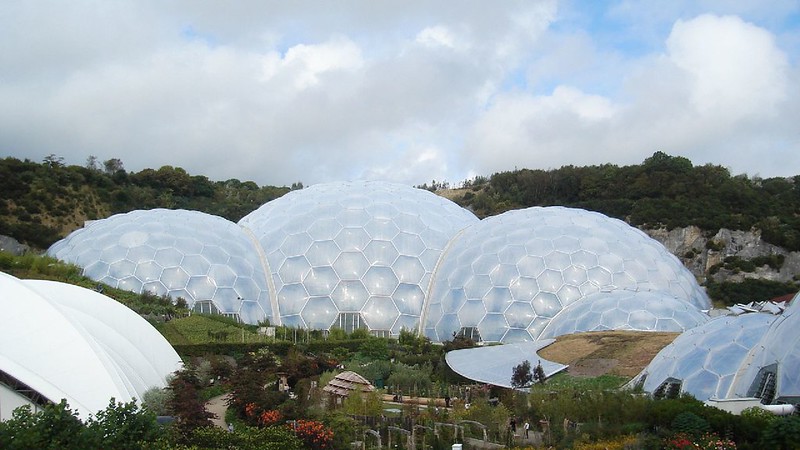
© Copyright Lawrie Cate and licensed for Attribution 2.0 Generic under this Creative Commons Licence.
3. Case Study 2: The Eden Project, Cornwall
The Eden Project, located in Cornwall, England, is a remarkable example of how innovative waste management strategies can be successfully integrated into large-scale construction projects. As a global center for environmental education and sustainability, the Eden Project showcases a commitment to reducing waste and promoting sustainability through its design and operational practices. In this section, we will delve into the specifics of how the Eden Project managed its construction waste, the strategies employed to minimize its environmental impact, and the lessons learned from this iconic project.
Project Overview:
a. Description:
-
- Location: Cornwall, UK
- Type: Environmental Education and Visitor Attraction
Key Features:
-
- Innovative Biomes: The Eden Project features large, geodesic biomes that house various ecosystems, including tropical and Mediterranean climates. These structures are not only architectural marvels but also serve as living laboratories for environmental education and research.
- Use of Reclaimed Materials: In its construction, the Eden Project utilized 6,000 tonnes of recycled steel for the biomes’ structure. This commitment to material reuse significantly reduced the need for new resources and demonstrated a sustainable approach to building.
- Construction Waste Minimization: The project employed precise cutting techniques and detailed material planning to minimize waste during construction. These practices ensured that material use was optimized and waste was kept to a minimum.
- On-Site Recycling Programs: The Eden Project implemented comprehensive on-site recycling programs to handle both construction and operational waste. This approach helped reduce the environmental impact of waste disposal and promoted a circular economy within the site.
- Educational Focus: The Eden Project serves as an educational platform, using its facilities to teach visitors about environmental sustainability, ecology, and the importance of effective waste management. This educational mission aligns with its operational practices and sustainability goals.
- Environmental Impact: The project has had a significant impact on demonstrating how large-scale initiatives can integrate sustainable practices effectively. It highlights the potential for major construction projects to contribute positively to environmental sustainability through thoughtful design and operational strategies.
b. Waste Management Strategies:
1. Material Reuse:
The Eden Project exemplifies the use of reclaimed and recycled materials, incorporating 6,000 tonnes of recycled steel into the construction of its biomes. This substantial reuse of materials not only diminished the demand for new resources but also highlighted the project’s commitment to sustainability and efficient resource management.
2. Construction Waste Minimization:
To minimize waste generation during construction, the Eden Project adopted several strategies. These included precise cutting techniques and meticulous planning of material usage. By ensuring that materials were used efficiently and waste was minimized, the project achieved a significant reduction in construction waste, demonstrating effective waste management practices from the outset.
3. On-Site Recycling:
The Eden Project implemented comprehensive on-site recycling programs for both construction and operational waste. This approach allowed for the direct management of waste within the project site, reducing the environmental impact associated with waste disposal. The on-site recycling programs supported a circular economy, promoting sustainability by reprocessing materials and minimizing waste sent to landfills.
c. Outcomes:
1. Performance:
The Eden Project significantly reduced waste generation through its strategic use of reclaimed materials and robust recycling programs. By incorporating 6,000 tonnes of recycled steel into the biomes’ structures and employing precise material planning during construction, the project effectively minimized waste and demonstrated a strong commitment to sustainable practices. The successful application of these waste management strategies underscores the project’s effectiveness in achieving substantial environmental benefits.
2. Impact:
The Eden Project has set a high standard for integrating sustainable waste management practices into large-scale construction projects. Its innovative approach to material reuse and on-site recycling serves as a prominent example of how major initiatives can incorporate environmental considerations effectively. This project has influenced future construction practices by showcasing how sustainability can be seamlessly integrated into large-scale developments, thereby inspiring other projects to adopt similar waste management strategies.
d. Challenges:
1. Logistics:
Coordinating the sourcing of materials and managing recycling on a large scale presented significant logistical challenges. Handling and processing a large volume of reclaimed and recycled materials required meticulous planning and coordination to ensure efficiency and effectiveness. The complexity of integrating these materials into the construction process demanded careful oversight and management to achieve the desired outcomes in waste reduction and resource efficiency.
2. Public Perception:
Educating visitors and stakeholders about the importance of waste management was a crucial aspect of the Eden Project’s strategy. The project aimed to raise awareness and demonstrate the value of sustainable practices through its educational exhibits and operational strategies. Aligning its mission with its waste management efforts required ongoing communication and engagement to effectively convey the benefits of sustainable construction and resource management to the public.
Reflection Element:
Reflect on the benefits and challenges of using reclaimed materials in large-scale projects, using the Eden Project as a case study.
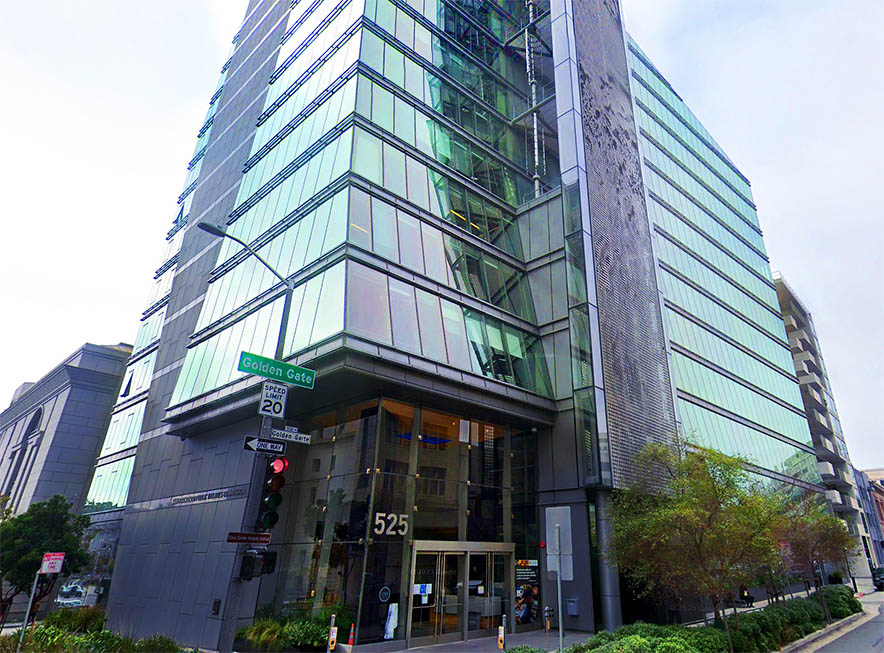
4. Case Study 3: The San Francisco Public Utilities Commission (SFPUC) Building
The San Francisco Public Utilities Commission (SFPUC) Building is a landmark in sustainable urban development, reflecting a commitment to environmental stewardship and innovative design. Located in San Francisco, USA, this building exemplifies how municipal projects can integrate advanced waste management practices and sustainable technologies to set new standards for public sector infrastructure. In this case study, we will explore the SFPUC Building’s approach to waste management, examine the strategies employed, and assess the outcomes and challenges faced during its development. Through this analysis, learners will gain insights into how public projects can successfully implement and benefit from comprehensive waste management strategies.
a. Project Overview:
Description:
-
- Location: San Francisco, California USA
- Type: Public Utilities Building
Key Features:
-
- Sustainable Design: The SFPUC Building exemplifies advanced sustainable architecture, integrating a range of green technologies and practices aimed at minimizing its ecological impact. This includes energy-efficient systems, sustainable materials, and a focus on reducing the building’s overall carbon footprint. The design reflects a commitment to environmental stewardship and sets a high standard for public buildings.
- Comprehensive Waste Management: During its construction, the SFPUC Building implemented rigorous waste management strategies, achieving notable success in waste diversion. The project featured on-site sorting and recycling facilities, and targeted a zero-waste goal by diverting 90% of construction waste from landfills. These practices not only exemplify effective waste management but also serve as a benchmark for similar public sector projects.
- Innovative Waste Practices: The building is recognized for its innovative approach to waste management, including detailed waste separation procedures and the provision of training for construction workers. These efforts ensured that the waste management goals were met and set a new standard for sustainability in public building projects.
b. Waste Management Strategies:
1. Zero Waste Goal:
The SFPUC Building set an ambitious zero waste goal, striving to divert 90% of construction waste from landfills. This objective was achieved through the implementation of stringent waste management protocols and effective recycling practices. By focusing on minimizing landfill use, the project not only reduced its environmental impact but also demonstrated a commitment to sustainable construction practices.
2. On-Site Sorting:
To optimize waste diversion, the SFPUC Building incorporated on-site sorting and recycling facilities. These facilities were designed to handle various types of construction waste, ensuring that materials were accurately separated and processed. This efficient sorting system enhanced the effectiveness of waste diversion efforts, enabling the project to meet its zero waste target and set a standard for waste management in large-scale public sector projects.
3. Education and Training:
A critical component of the waste management strategy was the comprehensive training provided to construction workers. This training covered proper waste separation and recycling procedures, ensuring that all personnel were well-versed in the project’s waste management practices. By equipping workers with the necessary knowledge and skills, the project fostered a culture of adherence to waste management protocols, contributing significantly to the overall success of the waste diversion goals.
c. Outcomes:
1. Performance:
The SFPUC Building made impressive strides in reducing landfill waste through its dedicated waste management strategies. By successfully diverting 90% of construction waste from landfills, the project demonstrated exceptional performance in waste reduction. Additionally, the efficient handling and recycling of materials resulted in significant cost savings, further showcasing the financial and environmental benefits of effective waste management.
2. Awards:
The SFPUC Building has garnered several accolades for its outstanding waste management practices and overall sustainability achievements. These awards underscore its role as a pioneering model in the public sector for integrating comprehensive waste management strategies. The recognition highlights the project’s success in setting new standards for environmental responsibility in large-scale public construction projects.
d. Challenges:
1. Complexity:
One of the major challenges faced during the construction of the SFPUC Building was the complexity involved in waste separation and recycling processes. Coordinating a large-scale site required intricate planning to manage various types of waste efficiently. Implementing on-site sorting and recycling facilities demanded detailed logistics and constant oversight to ensure that all waste streams were correctly processed and diverted from landfills.
2. Stakeholder Engagement:
Achieving the ambitious zero waste goal necessitated strong commitment and collaboration from all project stakeholders. Engaging diverse parties, including contractors, suppliers, and project managers, was crucial for maintaining alignment with the waste management objectives. Ensuring that everyone involved was dedicated to the zero waste goals required effective communication, regular updates, and ongoing education to foster a shared sense of responsibility towards the project’s environmental targets.
Reflection Element:
Reflect on the effectiveness of the zero waste goal strategy and think about how similar approaches could be implemented in other projects.
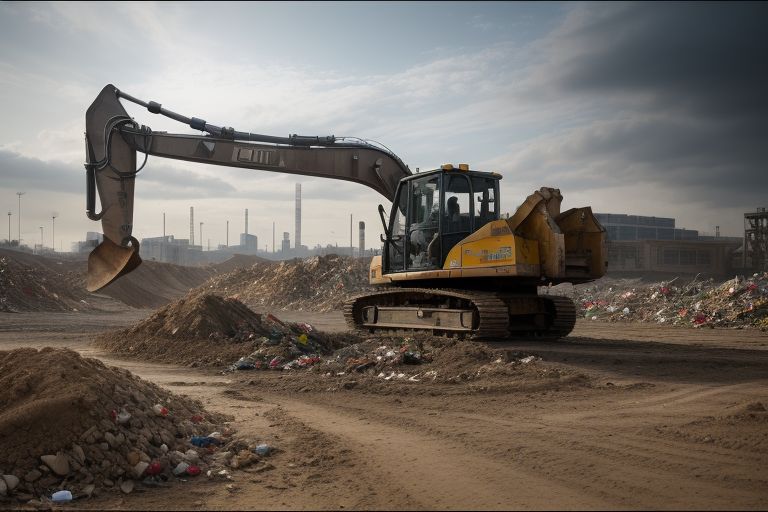
5. Reflection for Future Projects
As we conclude our exploration of these successful waste management case studies, it’s essential to reflect on the insights gained and consider their implications for future projects. This section will delve into the valuable lessons learned from the case studies of The Bullitt Center, The Eden Project, and the SFPUC Building. By analyzing the strategies, outcomes, and challenges of these pioneering projects, we aim to identify best practices and key takeaways that can guide and enhance waste management efforts in future construction initiatives. This reflection will help us understand how to apply these insights to new projects, ensuring continued progress towards sustainable and efficient waste management practices.
Key Points:
a. Key Takeaways
Summary: The case studies of The Bullitt Center, The Eden Project, and the SFPUC Building reveal several common waste management strategies and challenges. Key strategies include rigorous waste diversion practices, on-site sorting and recycling, and the use of reclaimed materials. These approaches have proven effective in minimizing landfill waste, reducing costs, and promoting sustainability. However, challenges such as managing complex waste separation processes and ensuring stakeholder engagement were also prominent.
By examining these case studies, it becomes clear that successful waste management is achieved through a combination of innovative strategies, robust planning, and strong commitment from all involved parties. The effectiveness of these approaches highlights their potential applicability to a wide range of construction projects, regardless of scale or type.
b. Application to Future Projects
The lessons learned from the case studies of The Bullitt Center, The Eden Project, and the SFPUC Building provide invaluable guidance for enhancing waste management practices in future construction projects. Key best practices and strategies include:
-
- Setting Ambitious Waste Reduction Goals: Following the example set by the SFPUC Building, setting clear and challenging waste diversion objectives can drive significant improvements in waste management. Establishing ambitious goals, such as achieving zero waste or diverting a high percentage of construction waste, sets a high standard and motivates all project participants to engage in effective waste reduction strategies. These goals should be integrated into project planning from the outset and supported by measurable targets and regular progress assessments.
- Implementing On-Site Recycling: The success of on-site sorting and recycling programs, as demonstrated by The Bullitt Center and The Eden Project, highlights the benefits of managing waste directly at the construction site. On-site recycling facilities allow for efficient separation and processing of waste materials, reducing the need for transportation and minimizing the environmental impact. Future projects should consider incorporating similar on-site recycling systems to enhance waste management efficiency and effectiveness.
- Using Reclaimed and Sustainable Materials: The innovative use of reclaimed materials in The Eden Project showcases the advantages of incorporating sustainable and recycled materials into construction projects. By prioritizing the use of materials with high recycled content and sourcing them locally, projects can significantly reduce their environmental footprint and support circular economy principles. Future projects should explore opportunities to integrate reclaimed materials and sustainable building practices into their design and construction processes, contributing to overall sustainability goals.
Applying these best practices can enhance waste management efforts in future projects by reducing waste generation, improving recycling rates, and fostering a culture of sustainability. These insights also emphasize the need for comprehensive planning, effective stakeholder engagement, and ongoing education to achieve successful waste management outcomes.
Reflection Element:
Reflect on insights gained from the case studies and brainstorm ideas for enhancing waste management in upcoming projects.
In this lesson, we delved into successful waste management practices through detailed case studies of The Bullitt Center, The Eden Project, and the SFPUC Building. We explored various strategies that contributed to their remarkable achievements in waste diversion and sustainability, from ambitious waste reduction goals to on-site recycling and the use of reclaimed materials. By understanding these real-world examples, we gained valuable insights into effective waste management techniques and how they can be applied to future projects.
As we transition to Lesson 9.3, we will shift our focus to another critical aspect of sustainable building practices: energy efficiency. This lesson, titled “Case Study Analysis: Implementing Energy-Efficient Designs,” will guide you through a series of case studies that showcase innovative approaches to energy-efficient building designs. We will analyze how these projects have successfully integrated energy-saving technologies and strategies to reduce their overall energy consumption.
By analyzing these case studies, you will gain insights into the practical application of energy-efficient design principles and their impact on sustainability. Prepare to explore how cutting-edge technologies and thoughtful design choices can lead to significant energy savings and improved building performance.

